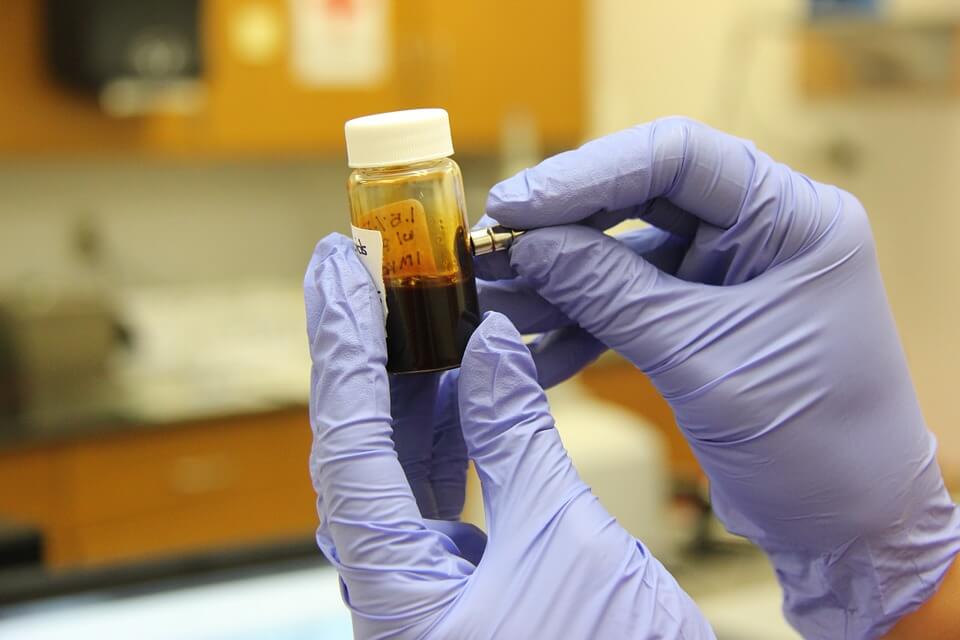If wind is breath to turbines, then oil is the lifeblood that keeps these machines running smoothly. And a healthy, well-oiled machine is one that can offer reliability and longevity.
It’s not unlike our own bodies, which tend to last and function better with proper care and nourishment. This, according to David DiNunzio, Wind Application Engineer at Castrol, “I compare turbine oil to the blood we have in our body,” he said during a presentation at the American Wind Energy Associations’ WINDPOWER 2016 conference and exhibition earlier this year in New Orleans.

Today there are more options than ever before for treating turbine oil and chemical adjustments can often be made up-tower to save time and money.
“Every year I go to my physician and get a complete physical. The doctor takes a couple vials of blood, sends it off, and a week or two later I get a report back about my overall health.” So far, there has been nothing to worry about. But just imagine, he said, that one time your blood tests are flagged and read outside the range of “normal”. You might be told you need immediate surgery or a blood transfusion.
“If it were me, I’d want to have more information before committing to either procedure,” DiNunzio said. “I’d want to dig a little deeper and maybe get more tests to confirm the diagnosis before taking serious action.”
In the wind industry, proper operations and maintenance also requires testing of the “lifeblood” used in turbines. Wind-farm owners or operators often send oil samples out for analysis to established laboratories. Oil properties and contaminants associated with component wear are then routinely assessed to monitor equipment health. Oil loaded with contaminants or wear materials could mean there is a problem with the gearbox.
But what if an oil property falls outside an acceptable “healthy” range? When is immediate action warranted and when is it time to dig a little deeper? “You have to recognize that there’s a lot of automation in the analysis process, and that there may be limitations in the test methods,” explained DiNunzio, and he is talking from experience. His team at Castrol tested this statement by sending identical, used turbine oil samples to five different laboratories.
“We did this in triplicate,” he said. “We sent them into different labs at different times and gathered the data back to compare because we wanted to see what the trends looked like.”
One of the parameters DiNunzio looked at were the results for water measurement levels. “I know this is sometimes a driver for understanding the condition of turbine oil and what type of contaminants are getting in there. But based on the test method and repeatability of that test method, well, there was no firm result. And because we don’t really know exactly what each test number was, all we can do is look at relative standard deviation.”
In comparing the different lab results, those numbers were bouncing up and down up by about 30%. DiNunzio explained that sometimes you can be plus or minus up to about 150ppm of water for this type of measurement but, because there are variables in the testing process, lab results will vary each and every time.
If you’re surprised, don’t be. “These labs are producing thousands of oil samples every month,” DiNunzio said. “And as I mentioned, results are largely automated and based on each lab’s own set of parameters.”
Particle counting provides another example of an automated process. It works by running oil through an automatic laser counter, and anything that interrupts that laser light is going to be marked or registered as “abnormal.”
“The issue: not all particles are wear materials,” DiNunzio said. “Things like air, water, and even some additives can interrupt the laser light and make the oil seem dirty.”
The International Organization for Standardization, or ISO, has developed a code for cleanliness included on most industrial oil analysis reports. The code can help establish targets and determine the overall cleanliness of a monitored system. “However, as cleanliness standards get tighter and you get bigger in the micron scale, errors can increase quite a bit because there are a lot fewer particles in there. Plus or minus 5, 10, 15 particles can change the cleanliness numbers significantly.”

Wind-farm owners often send turbine oil samples out for analysis to established laboratories. An oil with excessive contaminants or wear materials could mean there is a problem with the gearbox.
Another case in point: phosphorus. This is an example of a common additive element and extreme pressure additive indicator. With phosphorus, it is possible to get an accurate reading, at least for the most part. “When we got the phosphorus data back from all the different laboratories, we could see where the numbers fell in relation to what the numbers should have been — at least when using the ICP process.”
ICP or Inductively Coupled Plasma is a spectroscopy process used for measuring metallic and chemical elements that lends itself to high accuracy. But when identifying parts per million, or PPM, it is first necessary to have equipment calibrated for that element and for a particular range to ensure a constant level of accuracy.
“It’s like asking whether a ruler or a micrometer is being used to measure something. If your calibration is off for a particular element, results may come back significantly different from the value you were expecting.”
A 30% variance in lab results may not seem like much but when it comes to planning for oil changes and proper turbine O&M, these are costly decisions worthy of good logic. “So how much stock are you putting into one particular data point, and what kind of margin for error should you expect?” These are important questions, according to DiNunzio. “Ultimately, we want to use more than one data point and the trending information that leads us down a path that makes the most sense.”
He mentioned that there is also seasonal information to be gained from analyzing data over time. For instance, depending on the time of year, water numbers will go up or down in turbine oil. “It’s not uncommon for that to happen,” he said, “and it’s another good reason to look at a wider spread of information rather than one individual data point before making conclusions about your turbine’s oil health.”
If there’s a prime piece of advice DiNunzio can share with wind-farm operators it is to benchmark your data. “Pull samples from your turbines, send one to one lab and one to another lab. I mean it. And expect results to differ. You’re never going to get the same numbers back, but you do want to see that they are trending in the same direction.”
Aside from analyzing individual data points, also look at the look at the lab report as a whole. DiNunzio said it’s important to look for trends or interference. “If the particle count is going up, check to see if the iron is also going up. And verify if the PQ [particle quantification] index is also on the rise. Basically, you want to see if there are several parameters that are indicating the same thing, or if an out-of-range data point is merely a reflection of a lab’s measurement error.”
It’s also always good to take a look at the turbine itself. ““Make sure the oil sample you’re relying on is worthwhile,” DiNunzio advised. “Think about it: you’re taking a four-ounce sample out of an 80-gallon gearbox and hoping that it is representative of what’s seen throughout the whole machine.” So, it’s important that if there is a cause for concern in the oil analysis that it’s verified.
“The analysis is really only a good form of predictive maintenance, but to protect your asset, you probably want to dig a little deeper before you take costly corrective actions.” It’s just like with your own blood results. “Verify before you act,” said DiNunzio.
Fortunately, today there are more cost-effective options than ever before for treating turbine oil, if and when necessary. Chemical adjustments are now often made up-tower and are incredibly cost and time saving. “We’ve gotten creative thinking outside the box in terms of what we can do to improve oil condition up-tower as far as the chemistry goes. It saves from having to take a turbine down and lets technicians focus on other important jobs.”
For instance, treatments are now available that can chemically drive water out of oil and chemicals that can enhance an oil’s ability to release entrained air to break up foam.
“One of the latest technologies is an ability to replenish some of those additives that are used up in the normal course of protecting the gearbox. For example, as EP additives work — those are consumables — they also sacrifice themselves, so to speak, to prevent wear. They plate themselves out of those metal surfaces and don’t go back into the oil. So we expect to see a gradual decline of additives in oil samples.”
As the lifeblood of a wind turbine, oil can reveal a lot about the health of the gearbox. “And we are making more and more progress because we’re watching the trends and researching advancements,” said DiNunzio. “Today, the potential exists to extend the life of turbine oil from the common five-year life to an additional five years. Maybe even oil for life? That’s a big gain and real material savings worth analyzing.”
Filed Under: Lubricants, News





Thank you for the article. I would like to comment on Particle Counting. It should not be confused with Wear Debris Monitoring. There is often confusion because online/inline wear debris sensors (sometimes also referred to as Oil Debris Monitors or ODM’s) do count particles but the difference is that they count the wear metal debris generated by destructive wear modes (such as bearing spall or gear pitting), most often in a “full flow” monitoring sensor installation (before the oil filter). The full flow is a big advantage as all oil is continuously monitored as it leaves the sump prior to filtration. A flat line trend of wear debris counts indicates a healthy gearbox while an increasing debris count trend provides a very early indication of damage initiation (typically many months before gearbox functional failure). Other advantages of wear debris sensors are that these are fully autonomous, providing continuous remote monitoring with clear indication of gearbox health or damage severity (and progression/remaining life). The “Particle Counter” nomenclature refers to oil condition/cleanliness sensors. The amount of oil sampled through the online versions is very small, perhaps a few millilitres per minute. To monitor the machine (gearbox) condition most effectively the full flow (typically 50 to 200 litres per minute) should be monitored as the destructive wear modes will initially generate only small number of wear debris particles (e.g. only hundreds per day).